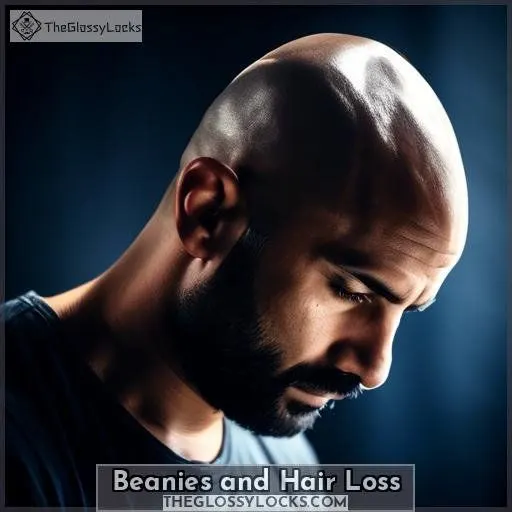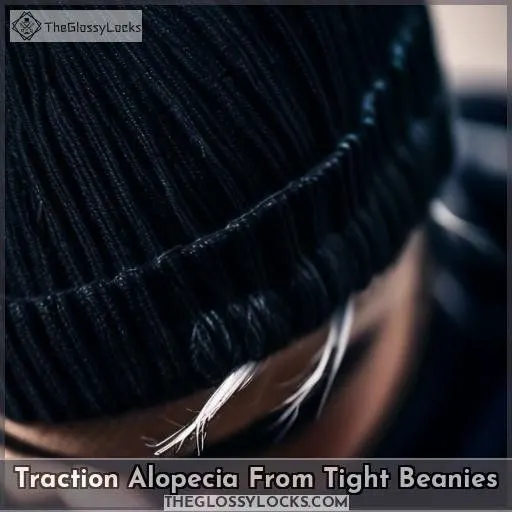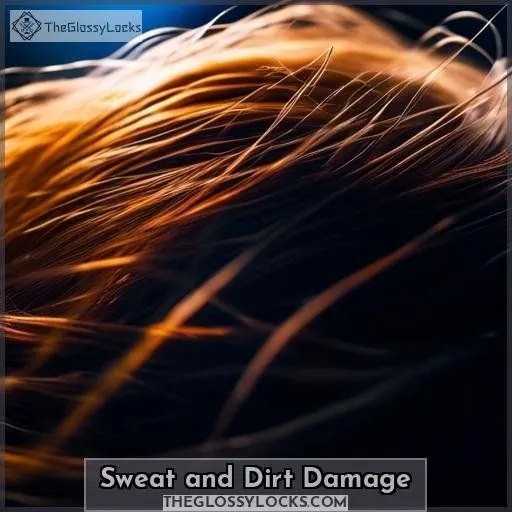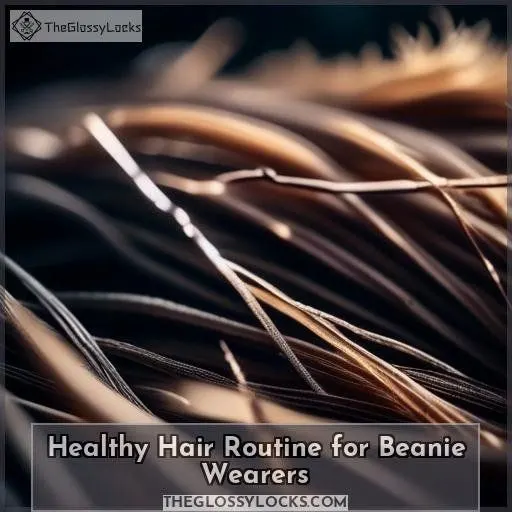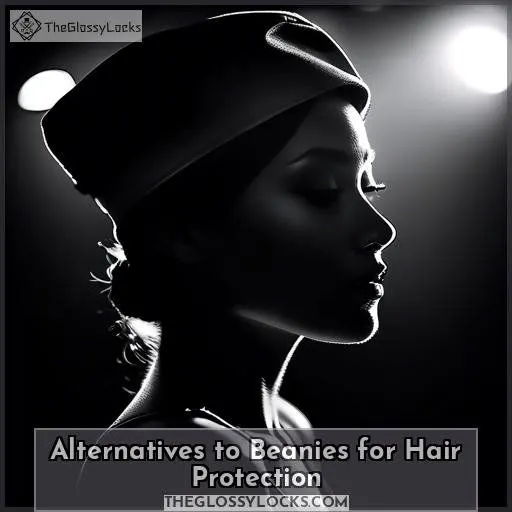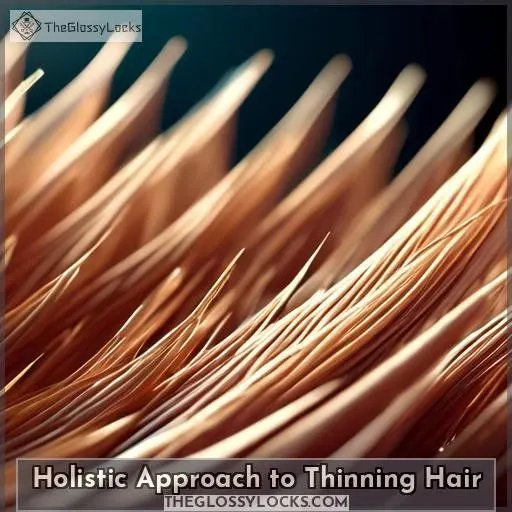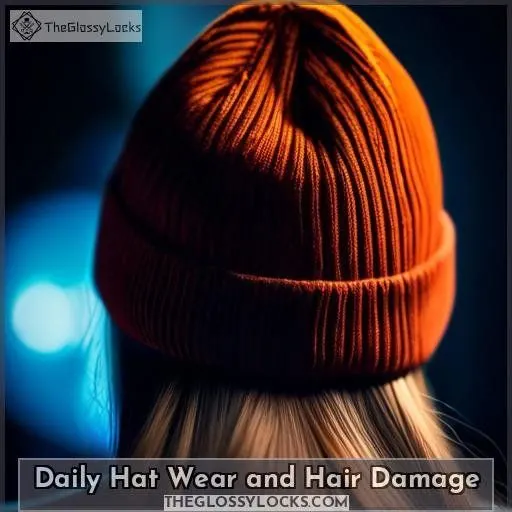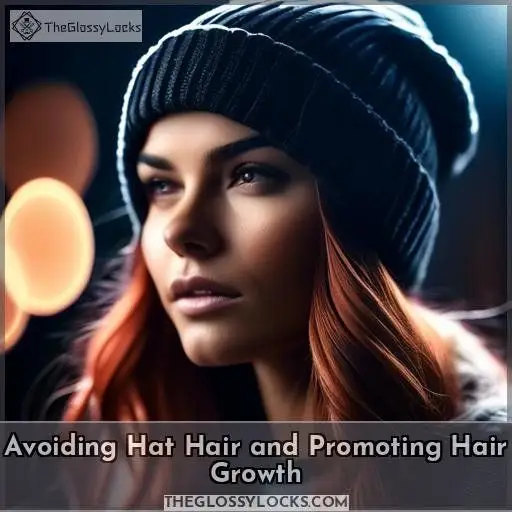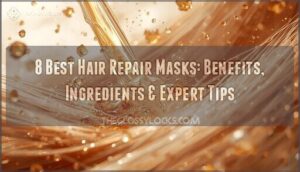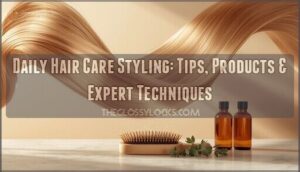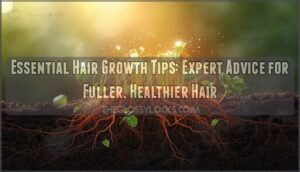This site is supported by our readers. We may earn a commission, at no cost to you, if you purchase through links.
Wearing beanies frequently raises concerns about potential hair loss or stunted growth.
As a hair specialist, I’ll unveil the truth.
Tight beanies can indeed cause traction alopecia by pulling on follicles.
However, loosely-fitted beanies aren’t directly harmful to growth.
The key lies in proper hair care routines like avoiding extended wear, maintaining scalp hygiene, and using gentle, nourishing products.
Embrace the beanie lifestyle while prioritizing your tresses’ well-being.
Table Of Contents
- Key Takeaways
- Are Beanies Bad for Hair Growth?
- Beanies and Hair Loss
- Traction Alopecia From Tight Beanies
- Sweat and Dirt Damage
- Healthy Hair Routine for Beanie Wearers
- Alternatives to Beanies for Hair Protection
- Holistic Approach to Thinning Hair
- Beanies and Hair Growth
- Protective Hats for Hair Health
- Daily Hat Wear and Hair Damage
- Avoiding Hat Hair and Promoting Hair Growth
- Frequently Asked Questions (FAQs)
- Conclusion
Key Takeaways
- Tight beanies can cause traction alopecia, a type of hair loss caused by pulling on the hair.
- Loosely-fitted beanies are not directly harmful to hair growth.
- Proper hair care routines, such as avoiding extended wear, maintaining scalp hygiene, and using gentle, nourishing products, can help maintain healthy hair while wearing beanies.
- Sweat and dirt build-up on the scalp can lead to scalp irritation and hair shedding, so it’s essential to clean your scalp and beanie regularly to prevent these issues.
Are Beanies Bad for Hair Growth?
No, beanies are not inherently bad for hair growth, but wearing them too tightly or for prolonged periods can cause friction and tension that may lead to hair damage and potential loss.
Beanies and Hair Loss
Are you worried that your beloved beanies might be causing hair loss? Fear not!
While it’s true that tight beanies can lead to traction alopecia, a type of hair loss caused by pulling on the hair, there’s no concrete evidence linking beanies to genetic hair loss.
In fact, consistent hat wearers may even experience less hair loss than non-wearers. However, it’s essential to be mindful of how you style your beanie.
Opt for accessories that don’t tug on your hair, and choose hats that allow your hair to breathe. Remember, a little bit of beanie hair styling can go a long way in maintaining healthy hair.
So, don’t ditch your beanies just yet!
Traction Alopecia From Tight Beanies
Traction alopecia is a type of hair loss caused by constant pulling on the hair, often due to tight hairstyles or headwear.
Wearing hats, including beanies, can contribute to this condition if the hats are too tight, as they can restrict blood flow to the hair follicles and cause temporary hair loss.
Over time, this can lead to permanent hair loss.
To prevent traction alopecia from tight beanies, it’s essential to wear them loosely and avoid wearing them too frequently.
Additionally, maintaining a healthy hair care routine, such as using natural hair serums and avoiding harsh shampoos and conditioners, can help promote thicker, healthier hair.
Sweat and Dirt Damage
Wearing beanies can cause scalp irritation and scalp bacteria due to sweat and dirt build-up, which can lead to scalp hygiene issues and hair shedding.
- Scalp Cleansing: Regularly clean your scalp and beanie to prevent the build-up of sweat and dirt. Use a gentle shampoo or antifungal shampoo to remove any excess oil and bacteria that may cause scalp irritation or yeast infections.
- Scalp Protection: Wear a clean beanie to avoid irritating your scalp. If you’re prone to sweating, consider using a moisture-wicking fabric or a breathable hat to keep your scalp dry and healthy.
- DHT Management: If you’re concerned about hair loss, consider using DHT-blocking products. DHT is a hormone that can damage hair follicles and contribute to hair loss. Some DHT-blocking products include ketoconazole shampoo and finasteride (a prescription medication).
- Hair Care Routine: Incorporate a holistic hair care routine that includes natural hair serums, gentle shampoos, and conditioners, and avoid harsh chemicals that can damage your hair and scalp.
By following these tips, you can minimize the negative effects of sweat and dirt on your scalp and hair while wearing beanies. Remember, a clean and healthy scalp is essential for maintaining healthy hair.
Healthy Hair Routine for Beanie Wearers
For those donning beanies to fend off the chill, maintaining a lush mane requires a bit of savvy.
First off, let’s debunk a myth: beanies aren’t the villains of hair growth. However, the snug fit of your favorite cap could invite trouble, like traction alopecia, if it’s too tight.
To keep your scalp happy and hair flourishing, embrace a routine that’s kind to both. Opt for gentle, moisturizing products that soothe rather than strip.
And for the gents battling male-pattern balding, fear not—this isn’t a hat issue but a genetic hand you’ve been dealt. In the quest for hair restoration, consider hats as allies, not enemies, when armed with the right hair care artillery.
Alternatives to Beanies for Hair Protection
As we navigate the complexities of hair health, it’s essential to explore alternatives to beanies for hair protection. While beanies have their benefits, they can also cause traction alopecia, prevent scalp breathing, and flatten hair.
- Loose-fitting hats: These hats prevent hair pulling and offer protection without causing damage.
- Bucket hats and straw hats: These hats protect hair from sun damage while allowing scalp breathing.
- Head scarves: Fashionable and protective, head scarves can be a stylish alternative to beanies.
Holistic Approach to Thinning Hair
As a hair specialist, I understand that hair loss can be a daunting concern for many individuals. However, it’s essential to approach it holistically, focusing on the overall health of your hair and scalp. Incorporating a variety of natural remedies and treatments into your hair care routine can significantly improve your hair’s appearance and vitality.
Firstly, let’s discuss scalp massage. This simple yet effective technique can promote hair growth, prevent hair loss, and improve hair thickness for some people. Massaging your scalp for around 10-20 minutes at a time, twice a day, can be beneficial. You can use your fingertips, a scalp massager, or even essential oils like peppermint, lavender, or rosemary to enhance the experience.
Next, consider incorporating herbal treatments into your hair care routine. Certain herbs, such as nettle, rosemary, and horsetail, have been shown to promote hair growth and strengthen hair. You can find these herbs in various hair care products, or you can make your own herbal infusions to use as a rinse or treatment.
Additionally, hair masks can be a great addition to your hair care routine. These treatments can help to repair damaged hair, nourish the scalp, and even stimulate hair growth. Look for masks that contain ingredients like biotin, keratin, or collagen, which can help to strengthen and thicken hair.
Lastly, don’t forget the importance of a balanced diet. Consuming a diet rich in vitamins, minerals, and antioxidants can help to support healthy hair growth. Foods like eggs, nuts, seeds, and leafy greens are all excellent sources of nutrients that can benefit your hair.
Beanies and Hair Growth
Beanies are a popular accessory, but they can have both positive and negative effects on hair growth.
- Flattening and Breakage: Wearing beanies can flatten your hair, giving it a flat, lifeless look. Over time, this constant pressure can cause breakage and damage to your hair strands, leading to hair loss.
- Oiliness and Dirt: Beanies can trap sweat and dirt, which can make your hair look greasy and unhealthy. This can lead to more frequent washing, which can further damage your hair.
- Traction Alopecia: Wearing tight beanies can cause traction alopecia, a form of hair loss that occurs when hair is pulled too tightly. This can lead to hair thinning and, in severe cases, bald patches.
To minimize beanie hair damage, consider the following tips:
- Choose Loose-Fitting Hats: Opt for beanies that fit comfortably without being too tight. This will reduce the risk of traction alopecia and prevent excessive pressure on your hair.
- Clean Your Beanie: Regularly wash your beanie to prevent the buildup of sweat, dirt, and oil. This will help keep your hair clean and healthy.
- Style Your Hair: After removing your beanie, use styling products to revive your hair and add volume. Dry shampoo can help absorb excess oil, while styling cream can add texture and fullness.
- Avoid Wearing Beanies Constantly: Give your hair a break from beanies by wearing other types of hats or headwear. This will help prevent constant pressure on your hair and scalp.
By following these tips, you can enjoy the style and warmth of beanies without causing significant damage to your hair.
Protective Hats for Hair Health
Protective hats are a must-have in any hair care routine. They come in various styles and materials, each designed to cater to different needs. For instance, sun hats are made from lightweight materials that protect your hair from harmful UV rays, while winter hats are insulated to keep your scalp warm. Seasonal hat wear is essential, as it helps maintain scalp health throughout the year.
When it comes to cleaning your hats, it’s crucial to follow the manufacturer’s instructions. Some hats can be machine washed, while others require hand washing. Regular cleaning helps prevent scalp discomfort and keeps your hats fresh.
Hat materials play a significant role in hair health. For example, hats made from breathable materials like cotton or linen are ideal for daily wear, as they allow your hair to breathe and reduce the risk of traction alopecia.
Hair product compatibility is another factor to consider. Some products can damage your hats or affect their performance. It’s advisable to choose hats made from materials that are compatible with your hair care routine.
Hat style and hair type are also essential considerations. Loose-fitting hats are ideal for those with fine or thinning hair, as they reduce the risk of hair pulling. For those with thicker or curly hair, hats with adjustable straps can be more comfortable and effective in preventing traction alopecia.
In conclusion, protective hats aren’t only a fashion statement but also a crucial part of maintaining healthy hair. By choosing the right materials, cleaning your hats regularly, and considering your hair type and style, you can enhance your hair health and achieve a well-rounded hair care routine.
Daily Hat Wear and Hair Damage
Daily hat wear can have both positive and negative effects on your hair health. Here are three things to keep in mind:
- Breathability and scalp ventilation: Tight hats can restrict airflow and cause discomfort, while loose-fitting hats with good breathability can help maintain a healthy scalp environment.
- Hat hygiene: Regularly cleaning your hat can prevent scalp issues and reduce the risk of hair damage from sweat and dirt.
- Hair-friendly hat fabrics: Some materials, like cotton or linen, are more breathable and less likely to cause scalp irritation than synthetic fabrics.
Avoiding Hat Hair and Promoting Hair Growth
To avoid hat hair and promote hair growth, it’s essential to maintain hat hygiene**, choose breathable fabrics, and use hair care products tailored to your hair type. Start by keeping your hats clean to prevent scalp irritation and damage. Breathable fabrics like cotton or linen allow air to circulate, reducing sweat buildup and preventing hair damage. Hair care products designed for hat wearers can help maintain healthy hair, such as natural hair serums to promote thicker, healthier hair.
When it comes to hat styles, choose loose-fitting hats that don’t pull on your hair. Hair accessories like headbands or clips can help keep your hair in place without causing damage. It’s also advisable to switch up your hat styles and rotate hats to reduce the strain on your hair.
In the realm of hair growth, it’s crucial to navigate the complexities of hair care with a holistic approach. This means addressing thinning hair with a bespoke hair care routine, investing in clinically tested plant-based ingredients**, and promoting healthy hair naturally. It’s not only about the hat; it’s about the whole picture.
In conclusion, avoiding hat hair and promoting hair growth involves meticulous attention to hat hygiene, breathable fabrics, and hair care products. It’s about finding the right balance between hat styles, hair accessories, and hair care routines. By doing so, you can unlock the secrets to healthy, growing hair and feel confident in your hats.
Frequently Asked Questions (FAQs)
Does wearing a beanie affect hair growth?
You’re right to be concerned about hair growth! Beanies won’t directly impact growth, but friction and sweat buildup could potentially exacerbate shedding or thinning. Stay mindful, but don’t stress – a balanced hair-care routine keeps your locks lush.
Can tight beanies cause hair loss?
You won’t go bald from beanies per se, but wearing super-tight ones can strain your hair follicles, accelerating traction alopecia and thinning over time. If you’re spotting excess shedding or sensitivity, loosen up or rotate hat styles – your scalp will thank you!
How does sweat and dirt affect hair health when wearing beanies?
Sweat and dirt trapped under beanies can clog pores, leading to irritation and weakened hair follicles. Always opt for breathable, loose-fitting hats to promote healthy hair growth.
What are some tips for maintaining healthy hair while wearing beanies?
You got this! Use a loose-fitting beanie, avoid sweat build-up, and rotate with other hats. Nourish your locks with a hair mask weekly, and air-dry when possible. With some TLC, your hair will thrive, beanie or not!
Can beanies be worn in a way that promotes hair growth?
As the old saying goes, prevention is better than cure. Yes, beanies can promote hair growth if you wear them loosely and keep your scalp clean.
Conclusion
Like carefully nurturing a delicate blossom, you can enjoy beanies while promoting hair growth by practicing proper hair care routines. Loosely wear beanies, maintain scalp hygiene, use nourishing products, and avoid extended wear. With this holistic approach, you’ll protect your tresses and embrace the beanie lifestyle without compromising hair health.


